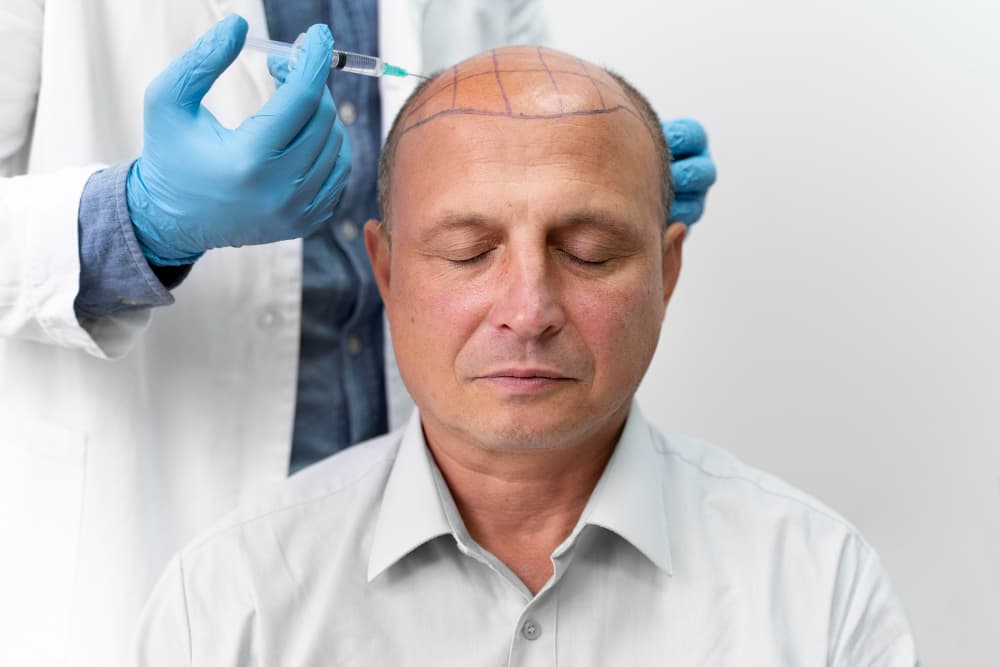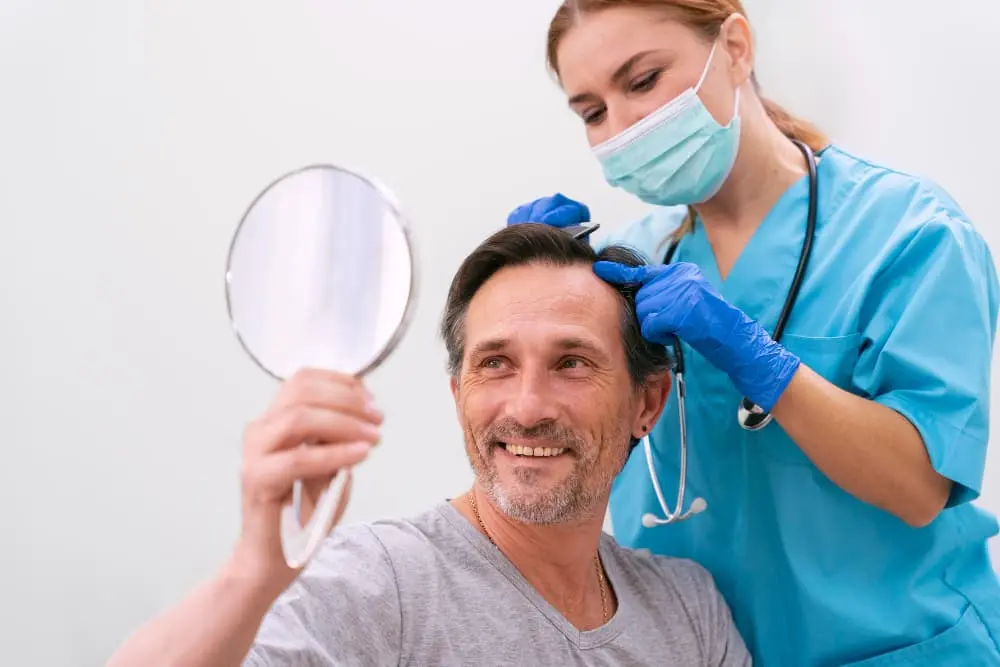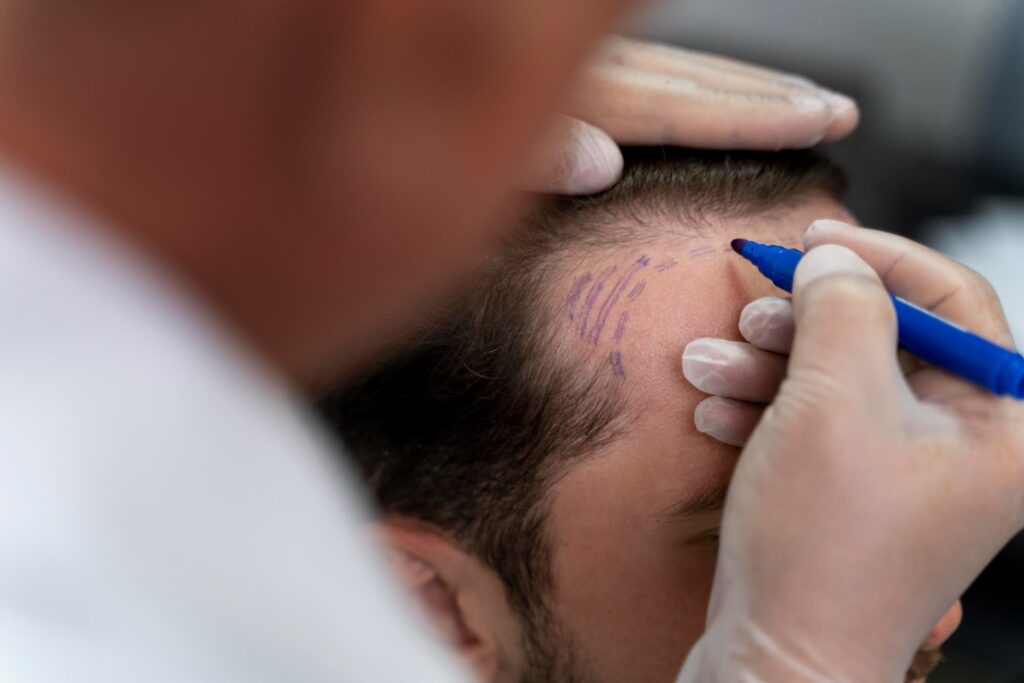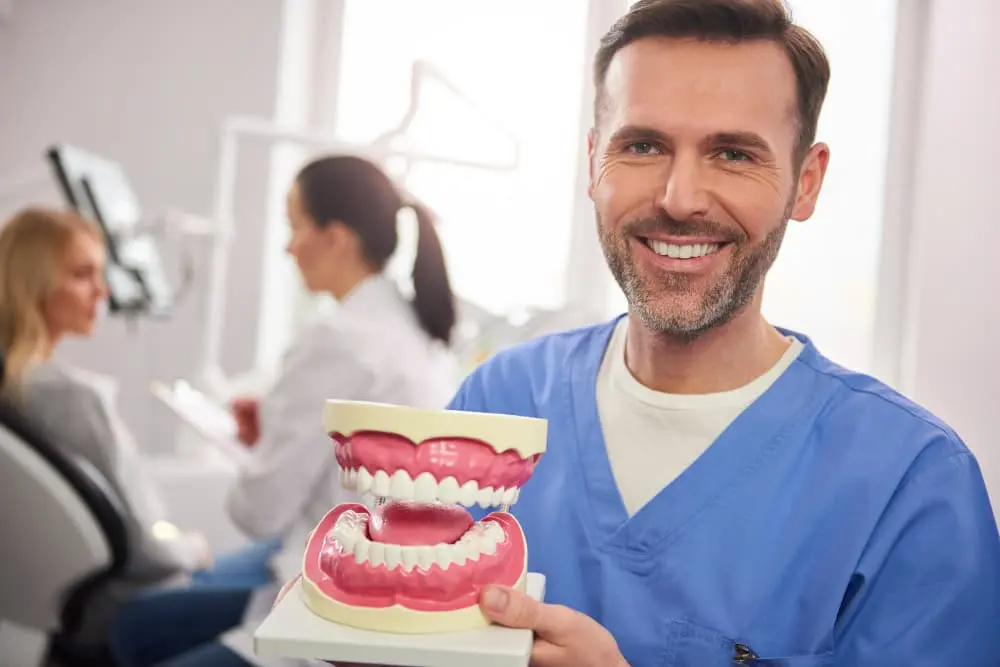
Considering a hair transplant but worried about the pain? You’re not alone. It’s natural to have concerns about any surgical procedure, and hair transplantation is no exception. However, modern advancements in techniques and anesthesia have significantly reduced the discomfort associated with hair transplants. Let’s put your mind at ease and explore what you can truly expect in terms of pain and discomfort during and after the procedure.
Understanding Hair Transplant Pain
While the thought of any surgical procedure can be a bit daunting, rest assured that modern hair transplant techniques prioritize patient comfort. Let’s explore how pain is managed during a hair transplant and the factors that can influence your experience.
The Hair Transplant Procedure and Pain Management
Hair transplant procedures, such as FUE (Follicular Unit Extraction) and DHI (Direct Hair Implantation), are typically performed under local anesthesia. This means that the areas of your scalp involved in the procedure will be numbed, ensuring you don’t feel any pain during the surgery itself.
Before the anesthesia is administered, your doctor may apply a topical numbing cream to further minimize any discomfort from the injections. Throughout the procedure, your comfort level will be closely monitored, and additional anesthesia can be provided if needed.
Factors Affecting Pain Levels
While the procedure itself is generally pain-free, you may experience some mild discomfort or soreness in the days following the transplant. The level of discomfort can vary depending on several factors, including:
- Individual Pain Tolerance: Everyone’s pain threshold is different. Some individuals may experience minimal discomfort, while others may feel more sensitivity.
- Extent of the Procedure: The size of the transplanted area and the number of grafts involved can influence the level of post-procedure discomfort. Larger procedures may naturally lead to slightly more soreness.
- Surgical Technique: The specific hair transplant technique used can also play a role in post-procedure discomfort. However, both FUE and DHI are minimally invasive techniques designed to minimize pain and scarring.
Rest assured that any discomfort experienced after a hair transplant is typically mild and manageable with over-the-counter pain medications. Your doctor will provide you with detailed post-operative instructions and pain management recommendations to ensure a comfortable recovery.
During the Procedure

The hair transplant procedure itself is designed to be as comfortable as possible. Let’s explore the pain management techniques used and the typical sensations you might experience.
Anesthesia and its Role in Pain Control
Before the procedure begins, your doctor will administer local anesthesia to numb the areas of your scalp where the hair follicles will be extracted and implanted. This ensures that you won’t feel any pain during the surgery.
The anesthesia is typically administered through a series of small injections, which may cause a slight stinging or pinching sensation. However, this is usually brief and well-tolerated. Once the anesthesia takes effect, you should feel no pain throughout the procedure.
Common Sensations During the Procedure
While you won’t experience pain, you may still feel some sensations during the hair transplant. These can include:
- Pressure or Tugging: You might feel some pressure or tugging as the hair follicles are extracted and implanted.
- Vibration: The tools used during the procedure may create a slight vibration or buzzing sensation.
- Numbness: The anesthetized areas will feel numb, and you may not have full sensation in those areas for a few hours after the procedure.
Overall, the sensations experienced during a hair transplant are generally mild and easily tolerated. If you experience any discomfort, don’t hesitate to communicate with your doctor, who can adjust the anesthesia or provide additional comfort measures as needed.
Post-Procedure Pain and Discomfort

While the hair transplant procedure itself is virtually painless due to local anesthesia, it’s natural to wonder about the level of discomfort you might experience afterward. Let’s break down what to expect in the days and weeks following your hair transplant.
Immediate Post-Procedure Pain
Once the anesthesia wears off, you may experience some mild soreness or tenderness in both the donor and recipient areas. This is a normal part of the healing process as your scalp recovers from the micro-incisions made during the procedure. The level of discomfort can vary from person to person, but it’s typically described as a mild aching or tightness.
Pain Management Tips for the First Few Days
- Over-the-counter pain relievers: Your doctor will likely recommend over-the-counter pain medications to manage any discomfort.
- Cold compresses: Applying cold compresses to the forehead or back of the neck can help reduce swelling and soothe any tenderness.
- Elevate your head: Keeping your head elevated while sleeping can also help minimize swelling and discomfort.
- Avoid strenuous activity: It’s important to avoid any strenuous activity or exercise for the first few days after the procedure to allow your scalp to heal properly.
Long-Term Discomfort and When to Seek Help
In most cases, any post-procedure discomfort should subside within a few days. However, if you experience severe or persistent pain, excessive swelling, bleeding, or any signs of infection, it’s crucial to contact your doctor immediately. These could be signs of complications that require prompt medical attention.
Remember, everyone’s healing process is different. Some individuals may experience minimal discomfort, while others may require a few days of rest and pain management. By following your doctor’s post-operative instructions and taking good care of yourself, you can ensure a smooth and comfortable recovery.
Minimizing Pain Through Advanced Techniques
At Istanbul Hair Institute, we understand that patient comfort is paramount. That’s why we utilize a combination of advanced techniques and modern anesthesia methods to ensure your transplant experience is as painless and comfortable as possible.
Modern Anesthesia Methods in Hair Transplants
Gone are the days of painful hair transplant procedures. Today, we employ sophisticated anesthesia techniques to numb the scalp effectively, eliminating any pain during the surgery.
- Local Anesthesia: A local anesthetic is administered to the donor and recipient areas of the scalp, ensuring complete numbness throughout the procedure.
- Sedation (Optional): For patients who experience anxiety or prefer a deeper level of relaxation, sedation options may be available. This allows you to remain comfortable and drowsy throughout the procedure.
Innovative Surgical Techniques to Reduce Pain
We utilize the latest hair transplant techniques, such as FUE (Follicular Unit Extraction) and DHI (Direct Hair Implantation), which are minimally invasive and designed to minimize trauma to the scalp. These techniques involve extracting and implanting individual hair follicles with precision, resulting in less tissue damage and reduced post-procedure discomfort.
Role of the Surgeon in Pain Minimization
The skill and experience of your surgeon play a crucial role in ensuring a comfortable hair transplant experience. Our team of highly qualified surgeons at Istanbul Hair Institute is dedicated to providing gentle and meticulous care, minimizing any potential discomfort during and after the procedure.
By combining modern anesthesia methods with innovative surgical techniques and the expertise of our skilled surgeons, we strive to make your hair transplant journey as pain-free as possible.
Comparing Pain in Different Hair Transplant Methods

When considering a hair transplant, it’s natural to wonder about the level of discomfort associated with different techniques. Let’s compare the two most common methods, FUE and DHI, in terms of pain and recovery.
Pain in FUE vs. DHI Hair Transplants
Both FUE (Follicular Unit Extraction) and DHI (Direct Hair Implantation) are minimally invasive procedures performed under local anesthesia, ensuring a virtually pain-free experience during the surgery itself. However, there might be subtle differences in the post-procedure discomfort levels.
- FUE: In FUE, tiny incisions are made in the donor area to extract individual hair follicles. This can lead to some mild soreness and tenderness in the donor area for a few days after the procedure. The recipient area, where the follicles are implanted, may also experience some discomfort, but it’s generally less intense than the donor area.
- DHI: DHI involves using a specialized implanter pen to directly implant hair follicles into the recipient area, eliminating the need for incisions. This can result in less post-procedure discomfort compared to FUE, as there’s minimal trauma to the scalp.
Overall, both FUE and DHI are considered to have minimal pain levels, and any discomfort experienced is usually manageable with over-the-counter pain medications. Your doctor will provide you with detailed post-operative instructions and pain management recommendations to ensure a comfortable recovery.
The choice between FUE and DHI ultimately depends on your individual needs and preferences. Factors such as hair loss pattern, desired hair density, and budget can influence the decision. It’s crucial to consult with a qualified doctor to discuss your options and determine the most suitable technique for you.
Istanbul Hair Institute's Approach to Pain Management

At Istanbul Hair Institute, we understand that undergoing a hair transplant is a significant decision, and we prioritize your comfort and well-being throughout the entire process. We’re committed to ensuring a pain-free and relaxing experience so you can focus on achieving your hair restoration goals.
Our Commitment to Patient Comfort
Your comfort is our top priority. From the moment you walk through our doors to the completion of your recovery, we strive to create a welcoming and stress-free environment. Our team of compassionate professionals will guide you through every step of the process, addressing any concerns you may have and ensuring you feel at ease throughout your hair transplant journey.
Advanced Techniques for Minimizing Pain
We employ the latest advancements in hair transplant technology and anesthesia to minimize pain and discomfort during and after your procedure.
- Precise Anesthesia Administration: Our experienced doctors utilize advanced local anesthesia techniques to ensure complete numbness in the donor and recipient areas, effectively eliminating pain during the surgery.
- Minimally Invasive Procedures: We specialize in FUE and DHI hair transplant techniques, which are known for their minimally invasive nature and reduced post-procedure discomfort. These techniques involve transplanting individual hair follicles with precision, resulting in less tissue damage and faster healing.
- Personalized Pain Management: We understand that everyone’s pain tolerance is different. Our doctors will work with you to develop a personalized pain management plan that addresses your specific needs and ensures a comfortable recovery.
At Istanbul Hair Institute, we believe that hair restoration should be a positive and empowering experience. Our commitment to patient comfort and advanced techniques ensures that you can achieve your hair goals without unnecessary pain or discomfort.
Frequently Asked Questions (F.A.Q.)
We understand that concerns about pain are natural when considering a hair transplant. Here are answers to some of the most common questions we receive, to help put your mind at ease.
No, hair transplant surgery is generally not painful. Thanks to modern local anesthesia techniques, the procedure itself is virtually painless. You may feel a slight pinch or pressure during the initial injections, but once the anesthesia takes effect, you should experience no pain throughout the surgery.
Most patients experience minimal discomfort after the procedure, with any soreness or tenderness usually subsiding within a few days. The level of discomfort can vary depending on the extent of the surgery and individual pain tolerance, but it’s typically described as a mild ache or tightness.
If you do experience any discomfort after the procedure, your doctor will likely recommend over-the-counter pain medications like acetaminophen or ibuprofen. Applying cold compresses to the forehead or back of the neck can also help alleviate any swelling or tenderness.
While hair transplant surgery is minimally invasive, it’s generally recommended to take a few days of rest to allow your scalp to heal properly. Strenuous activities or exercise should be avoided for at least a week. Most patients can return to work or their usual routine within a few days, as long as they avoid any activities that could put strain on the scalp.
Long-term pain issues are extremely rare following a hair transplant. In most cases, any discomfort experienced is temporary and resolves within the first few days or weeks. If you experience any unusual or persistent pain, it’s important to contact your doctor promptly to rule out any potential complications.
Recent Posts
-
 Does Creatine Cause Hair Loss? Separating Fact from Fiction21 Jan 2025
Does Creatine Cause Hair Loss? Separating Fact from Fiction21 Jan 2025 -
 How Long Does Hair Transplant Last? A Comprehensive Guide to Long-Term Results15 Jan 2025
How Long Does Hair Transplant Last? A Comprehensive Guide to Long-Term Results15 Jan 2025 -
 Hair Loss After Hair Transplantation: Is It Normal and What to Do?13 Jan 2025
Hair Loss After Hair Transplantation: Is It Normal and What to Do?13 Jan 2025 -
 Donor Area in Hair Transplant: All You Need to Know - Istanbul Hair Institute06 Jan 2025
Donor Area in Hair Transplant: All You Need to Know - Istanbul Hair Institute06 Jan 2025 -
 The Connection Between Oral Health and Overall Health03 Jan 2025
The Connection Between Oral Health and Overall Health03 Jan 2025

